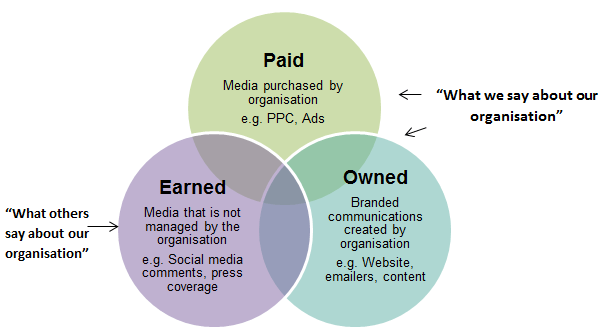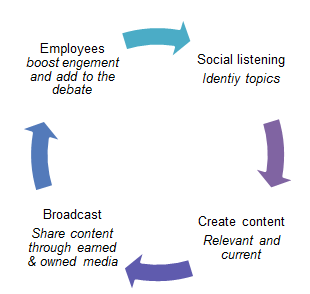
The usage and relevance of social media in b2b markets is a topic of wide and detailed debate. The purpose of this article is not to deliver a silver bullet for converting social media leads into sales or to demonstrate the ROI per tweet. Rather, it focuses on how companies can:
- utilise social media to inform the content it creates, and deliver content that is relevant to its market needs, and the latest trends
- utilise its own employees to boost its ‘earned’ media exposure, and ultimately the way it is perceived by the market at a more personal level
Paid, Earned, and Owned Media
Over the past few years marketers have typically broken their different types of available media down into paid, earned and owned media. There have been a number of developments and additions to this model in recent years (typically driven by new technologies and new social channels), with new categories ranging from ‘divergent’ media, ‘convergent’ media, and ‘social’ media. For simplicity, let us look at the traditional Paid, Earned and Owned media model, which is outlined below:

What we are particularly interested in with this article, is the use of social media listening to make an organisation’s owned media more relevant and ‘of-the-moment’. This in turn has an impact on the level of engagement in earned channels, and in what others are saying about the organisation.
The importance of cutting through the noise
The use of content marketing has grown rapidly over recent years, as companies seek to generate more and more owned media content – indeed, the term itself has become so omnipresent that some companies have sought to set up ‘content farms’ with teams of content generators churning out as much content as a humanly / digitally possible. But is this approach of maximising the volume of content the best approach? Is it simply a case of slinging as much content at the digital wall as possible and seeing what sticks and gets shared?
We have seen a trend recently of companies moving to a more focused approach to generating relevant content – something that is extremely important in making sure content stands out and is engaging. One of these approaches is utilising social listening to generate content that is pertinent to what an organisation’s target market is talking about. Using social listening tools (such as Radian 6, Brandwatch, Sysomos et al), a company can analyse the types of topics and themes that its target market is talking about at a given time (and in a given geographic location).
Using keyword tags, companies can identify the types of topics they would expect people to be talking about in their sector, and then look for any adjacent themes being discussed. A report is then put together outlining the latest trends and points of discussion. This report can then be used by the marketing team to decide which types of content to generate based on the most discussed topics in its sector.
The long and short of this approach is that a smaller amount of content can be developed, but that which is the most relevant and ‘on-the-pulse’ of what the market is talking about at the moment.
The power of people to spread the word
Whilst a company can generate relevant and topical content, it could make much more of it by encouraging a culture of sharing and commenting on content amongst its staff. For example, a piece of content shared via a link on a company’s Twitter account to its 40,000 followers may fall on 39,999 deaf ears. If one of the company’s senior staff members, or one of the sales team, were to share the story on their own social media (professional accounts such as their LinkedIn account, rather than their Facebook account), the content may find its way to the right people quicker and with higher engagement. When shared by a trusted individual, it is more likely to stimulate debate between the employee and the customers, and has an impact on how people position the organisation’s staff as well as the company. If all employees are encouraged to share and add to the debate in this way, it will amplify the impact of the content with each employee involved.
Indeed, some b2b companies have gone one step further and empowered their employees to generate their own content as long as it is relevant and adds to the debate (this may seem obvious to most companies – but many companies (particularly the large enterprises) typically have very restrictive social media policies which would not be conducive to this sort of task).
In summary
The above is only one of many different approaches that could be employed in a company’s social media strategy – indeed, many approaches would only be relevant to certain sectors and audiences. However this strategy is certainly something we have seen some b2b companies employing with a good degree of success. We can summarise this approach in the model below:

What do you think to the above? Have you come across similar strategies or different strategies? Please let us know in the comments section below.


